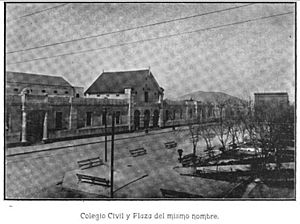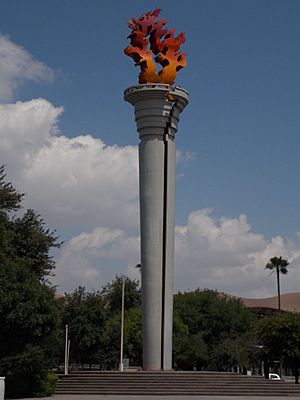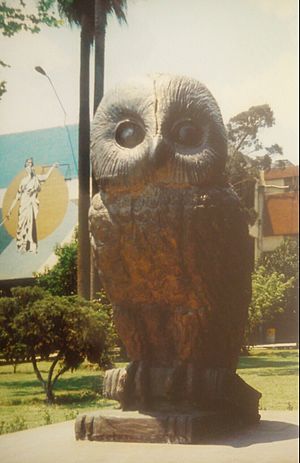Autonomous University of Nuevo León facts for kids
|
Universidad Autónoma de Nuevo León
|
|
 |
|
| Motto | Alere Flammam Veritatis |
|---|---|
|
Motto in English
|
"Encouraging the flame of truth" |
| Type | Public |
| Established | 25 September 1933 |
| Endowment | US$490 million (2014) |
| Rector | Santos Guzmán López |
|
Academic staff
|
6,894 (2022) |
| Students | 214,871 (as of 2022) |
| Undergraduates | 130,179 (as of 2022) |
| Postgraduates | 5,209 (as of 2022) |
|
Other students
|
79,427 (high school) (as of 2022) |
| Location |
,
Mexico
25°43′38″N 100°18′37″W / 25.72722°N 100.31028°W |
| Campus | 7 across the state; mostly urban. |
| Colors | Blue and Yellow |
| Nickname | Tigres |
| Affiliations | ANUIES, CUMEX, CONAHEC, International Association of Universities, ONEFA |
The Autonomous University of Nuevo León (which means Universidad Autónoma de Nuevo León or UANL in Spanish) is a big public university in Nuevo León, a state in northern Mexico. It has seven different locations, called campuses, across the state.
This university was started on September 25, 1933, and was first called the University of Nuevo León. It is now the third largest public university in Mexico based on how many students it has. It is also the most important place for higher education in Northeastern Mexico, offering many different study programs. The main office of the university is in San Nicolás de los Garza, which is a city near Monterrey.
The UANL has several campuses. The main one is called “Ciudad Universitaria” (University City). Here you can find the main offices, and colleges for subjects like Law, Engineering, Chemistry, and Architecture. It also has sports facilities, including football and soccer stadiums. Other campuses focus on different areas, such as Health Sciences (for Medicine, Dentistry, and Nursing) and Humanities and Fine Arts (for Visual Arts, Music, and Communication). There are also campuses for Agricultural Sciences and Earth Sciences.
The university has many resources for its students. It has 84 libraries with over 2.2 million books. There are 27 research centers where 438 national researchers work. The university also publishes 16 academic magazines, has 9 bookstores, 25 computer centers for students, and 53 cafeterias. Many groups have ranked UANL as one of the best public universities in Mexico and Latin America.
Contents
History of UANL
How the University Started
The idea for this public university began a long time ago, in 1859. That's when the Civil Academy (Colegio Civil) started offering classes. This academy was first thought of by Governor Santiago Vidaurri. It was built by his successor, José Silvestre Aramberri. The academy supported classes in Pharmacy and Medicine that José Eleuterio González had been teaching for many years. It also offered courses in Law and a preparatory school (like a high school). Its first leader was José de Jesús Dávila y Prieto.
Later, on October 29, 1932, different schools in the state, like the Law, Medicine, and Pharmacy schools, along with the Civil Academy and a teacher training school, suggested creating a state university. They sent their plan to the local government, the Congress of Nuevo León. On November 7, 1932, the congress approved the idea. So, on September 25, 1933, the University of Nuevo León officially began. Héctor González González was chosen as the first leader of the university.
In its first year, the university had 1,864 students and 218 professors. It included different schools for Medicine, Law, Engineering, and Chemistry, plus a teacher training school and a preparatory school. However, the university faced some challenges and was closed by the state government on September 25, 1935. It reopened almost eight years later, on September 13, 1943.
Growing and Becoming Autonomous
As the university grew, it needed its own space. So, in 1958, construction began on its own campus, called University City (Ciudad Universitaria). This large academic area is located in San Nicolás de los Garza, a city close to the state capital. In 1967, its outdoor stadium was completed.
From 1968 to 1972, the university experienced student protests and disagreements. By 1971, these protests led the government to agree to stop interfering in the university's internal matters. This agreement gave the university a special status called a statute of autonomy. This is why its name changed to the Autonomous University of Nuevo León (Universidad Autónoma de Nuevo León). "Autonomous" means it can make its own decisions without too much outside control.
In the late 1990s, the university decided to let a company manage its professional football (soccer) team, the Tigres de la UANL. The team has continued to play in the Mexican professional league. The team still belongs to the UANL.
UANL Campuses
The university has seven main campuses located throughout the state:
- University City (Ciudad Universitaria) is in San Nicolás de los Garza. It has thirteen different schools, a large 43,150-seat outdoor stadium, two main libraries, computer labs, cafeterias, and the main bookstore.
- Agricultural and Animal Sciences Campus is in Escobedo. This campus has branches of the Agronomy (study of crops) and Veterinary Medicine schools. It also has centers for research in food sciences and business development.
- Health Sciences Campus is in Monterrey. This campus is home to the Schools of Dentistry, Medicine, Nursing, Psychology, and Public Health and Nutrition. It also includes the University Hospital and a health clinic.
- Marin Campus is in Marin. This campus is where the School of Agronomy is located.
- Mederos Campus is also in Monterrey. Here you will find the Schools of Economics, Communication Studies, Music, Political Sciences, Stage Arts, and Visual Arts. It also has the university theater and a center for bilingual education research.
- Linares Campus is in the southern city of Linares. This campus houses the Earth Sciences and Forestry schools, along with a branch of the Accounting and Business Administration faculty.
- Sabinas Hidalgo Campus is in Sabinas Hidalgo. This campus has local branches of the Law and Business Administration schools.
High Schools (Preparatorias)
The university also manages 36 high schools. Seven of these are Technical High Schools, and one is a Bilingual International High School. The rest are two-year high schools. Additionally, 25 other high schools around the state are connected to the university. This means these schools follow the rules set by UANL, such as having certain libraries, labs, classrooms, and approved school programs with certified teachers.
How the University is Organized
The current leader of the university is Santos Guzmán López. The university also has its own symphony orchestra, a smaller chamber orchestra, and a band that plays regional music called El Tigre.
UANL Athletics
The sports teams at UANL are known as the Tigres (Tigers).
The American football team, called the Auténticos Tigres, is very successful in the ONEFA league. This team has won five national championships (in 1974, 1977, 2009, 2011, and 2012). They play their games at the Estadio Gaspar Mass.
UANL teams have also won the national universiade (a sports competition for university students) in 2006, 2007, 2008, and 2009.
The university's sports facilities include the Raymundo "Chico" Rivera Stadium (for football and athletics), the Luis Eugenio Todd Gym, a baseball park, an indoor football field, and a tennis center with four courts.
The professional football (soccer) team, Tigres de la UANL, was managed by the UANL until 1996. At that time, the team's management was given to a company called Cemex through a 30-year agreement. However, the team has always belonged to the UANL. The Estadio Universitario is located on the main university campus. It sometimes hosts games for the Auténticos Tigres and other university events.
The University Olympic Aquatic Centre Centro Acuático Olímpico Universitario is one of the best swimming centers in Mexico. It is also located on the main campus and is home to swimming, water polo, diving, and synchronized swimming teams.
Famous Alumni
Leaders and Public Servants
Many people who studied at UANL have become important leaders, including:
- Jorge Treviño (Governor from 1985–1991)
- Sócrates Rizzo (Governor from 1991–1996)
- Fernando Elizondo Barragán (Governor in 2003)
- José Natividad González Parás (Governor from 2003–2009)
Some have also served in the national government:
- Reyes Tamez
- Luis Eugenio Todd Pérez
- María Teresa Herrera
- The business leader Mauricio Fernández Garza.
- Jose Fernando Garza Cazares
Notable architects:
- Cesar Dominguez.
- Jose Said Salazar Almaguer.
Athletes
UANL has also produced many talented athletes:
- Raúl González (Olympic medal winner in racewalking)
- Luis Rosendo Ramos Maldonado (Olympic cyclist and Pan American Games medal winner)
- Elsa García (Olympic gymnast)
- Mariana Avitia (Olympic archer)
- Marisela Cantú (Olympic gymnast)
- José Luis Sánchez (Olympic shooter)
- Natalia Zamora (Olympic shooter)
- Paola Longoria (World's #1 professional Racquetball player)
- Samantha Salas (Racquetball player)
See also
 In Spanish: Universidad Autónoma de Nuevo León para niños
In Spanish: Universidad Autónoma de Nuevo León para niños
- XHUNL-FM
- XHMNU-TDT
- Tigres de la UANL
- List of universities in Mexico





